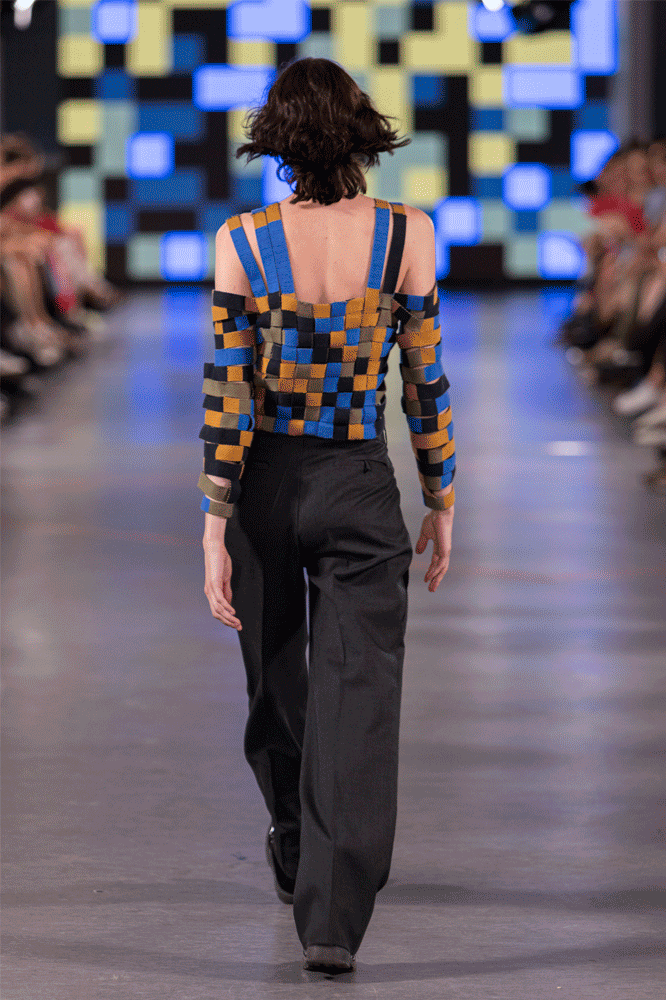Die Kombination von Textilien mit digital auslesbaren Codes ermöglicht es der Designerin durch die Kleidungsstücke mit den Träger*innen zukommunizieren.
Durch diese Verbindung von Mode und Technologie wird das Kleidungsstück selbst zu einem Medium, das mit den Konsument*innen interagiert und ihnen ermöglicht, eine tiefere Verbindung zur Mode und zu den dahinterstehenden Geschichten herzustellen.
Wir leben in einer Zeit, in der der Ruf nach Wandel in der Modeindustrie immer lauter wird.
Modemarken suchen verstärkt nach Methoden um transparenter und kreislauffähig zu werden. Ab 2025 wird ein digitaler Produktpass für jeden Modeartikel in der EUlt PEF-Programms der Europäischen Kommission, verpflichtend eingeführt.
Strick-ID entwickelt eine neue Art der Darstellung von Daten in 2D, eine eindeutige Identifikationsnummer materialisiert als Gestrick. Ähnlicheinem QR-Code, jedoch visuell ansprechend und für das menschliche Auge nicht sofort als digitaler Marker erkennbar.
Durch das Scannen der Textilien mit dem Handy können die in den Codes enthaltenen Informationen entschlüsselt werden. Verbraucher*innen erhalten so detaillierte Informationen über ein Produkt, wie beispielsweise verwendete Materialen, Produktionsbedingungen und den ökologischen Fußabdruck. Transparente Darstellungen der Lieferketten geben Einblickin den Weg, den das Produkt zurückgelegt hat, von der Herstellung bis zum Verkauf. Darüber hinaus zeigt die Designerin ihre Inspiration für die Kollektion und Herstellungs Prozesse es können auch persönliche Geschichten der Träger*in gespeichert und für zukünftige Besitzer hinterlassen werden.
The development of knit patterns with digitally readable codes enablesgarments and designers to communicate with wearers.
Through this combination of fashion and technology, the garment itself becomes a medium that interacts with consumers, allowing them toconnect more deeply with fashion and the stories behind it. We live in atime when the call for change in the fashion industry is growing louder.
Fashion brands are increasingly looking for methods to become more transparent and circular.
According to the European Commission's PEF program, a digital productpassport will be mandatory for every fashion product in the EU starting in2025.
Knit ID develops a new way of representing data in 2D, a unique identification number materialized as a knitted fabric. Similar to a QR code,but visually appealing and not easily recognizable to the human eye as adigital marker, these codes can be scanned in textiles to decipher the information they contain. Consumers inside thus receive detailed information about a product, such as material consumption, production conditions and the ecological footprint. Transparent representations of the supply chains provide insight into the path the product has taken, from production to sale. In addition, the designer shows her inspiration for the collection, personal stories of the wearer can also be stored and left for future owners. In this way, the garment becomes a means of communication and allows consumers not only to wear clothes, but also to experience the stories and values of the brand and the previous wearers.
Die Arbeit "Textile- ID" wurde im Rahmen der Fashion Show Biomaterialien, Vielfalt und Empowerment. am 22. Juni 2023, in der WEST Bibliothek der Alten WU Wien, Augasse 2-6 in Wien gezeigt.
